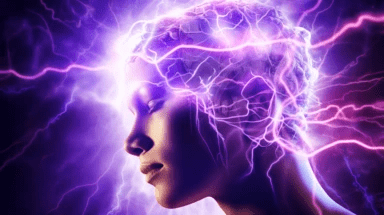Temporal Lobe Epilepsy Explained: Insights into Hallucinations & Creativity
Hippocrates, widely regarded as the “Father of Medicine”, is a significant figure in the history of medical science. One of the most noteworthy treatises attributed to him is “On the Sacred Disease“, which discusses temporal lobe epilepsy. This work stands out because it represents one of the earliest attempts to understand disease in terms of natural rather than supernatural causes.
The treatise “On the Sacred Disease” is essentially a rejection of the superstition that epilepsy, also known as the “sacred disease,” was a form of divine punishment or a result of evil spirits. Hippocrates argues that like other diseases, epilepsy has natural causes, and it is not more divine or sacred than other diseases.
He argued that epilepsy was due to an imbalance of the four humors (blood, phlegm, yellow bile, and black bile) in the body, a theory prevalent in ancient Greek medicine. He particularly emphasized the role of phlegm. In Hippocrates’ view, when phlegm flowed abnormally from the brain into the body, it could cause seizures.
Hippocrates’ treatise on epilepsy was revolutionary in its time and marked a shift from attributing illness to divine intervention to identifying physical causes. While we now understand epilepsy very differently, his approach helped pave the way for modern medicine by promoting the concept of rational understanding and treatment of diseases.
Historical Figures with Epilepsy
There are several historical figures that are thought to have had epilepsy, though the diagnosis in these cases is often speculative due to the distance in time and differences in medical understanding. Here are some examples:
- Julius Caesar: Roman military general and statesman. His reported symptoms have led some to believe he had epilepsy, but the diagnosis remains debated.
- Pharaoh Akhenaten: An ancient Egyptian pharaoh, known for his attempt to establish monotheism. His seizures, according to some historical accounts, have led to suggestions of epilepsy.
- Alexander the Great: The Macedonian king and conqueror, his sudden bouts of weakness and periods of intense headaches have led some historians to suggest he might have had epilepsy.
- Joan of Arc: A French heroine and saint of the Roman Catholic Church, she reportedly had visions and heard voices, symptoms that some neurologists suggest could have been hallucinations caused by epilepsy.
- Vincent van Gogh: A Dutch post-impressionist painter, it’s believed by some that he suffered from temporal lobe epilepsy, which might have contributed to his bouts of mental illness.
- Fyodor Dostoevsky: A renowned Russian novelist, he had well-documented epilepsy, which is reflected in some of his characters who also suffer from seizures.
- Napoleon Bonaparte: French military and political leader. There is speculation that he might have had epilepsy, but this is disputed.
- Lewis Carroll: The author of “Alice’s Adventures in Wonderland,” Carroll had a history of migraines and potential episodes of lost time and consciousness, leading to speculation about epilepsy.
- St. Paul the Apostle: Some theories suggest that St. Paul’s “thorn in the flesh” and spiritual visions could be attributed to temporal lobe epilepsy.
- Pope Pius IX: He served as Pope from 1846 to 1878, and reportedly had epilepsy.
- Joseph Smith: The founder of the Latter Day Saint movement reportedly had seizures, leading some to speculate that he had epilepsy.
- St. Teresa of Avila: A prominent Spanish mystic, writer and reformer, St. Teresa reportedly had fainting spells and visions, leading some to suggest she might have had epilepsy.
- Margery Kempe: An English Christian mystic, Kempe’s visions and spiritual experiences have been interpreted by some as possible signs of epilepsy.
- Emanuel Swedenborg: A Swedish theologian and mystic, some researchers have suggested that his visions could be attributed to complex partial seizures, a type of epilepsy.
- Ellen G. White: Co-founder of the Seventh-day Adventist Church, her religious visions have led some to speculate that she might have had epilepsy.
- Sadhu Sundar Singh: An Indian Christian missionary, Singh’s mystical experiences and visions have led some to suggest he may have had epilepsy.
- Neil Young: This legendary musician has openly discussed his experiences with epilepsy.
Remember that these posthumous diagnoses are all speculative and based on historical accounts, which might not be entirely accurate or complete. Epilepsy was not well understood until relatively recently, and many conditions can mimic its symptoms.
The connection between epilepsy and creativity, visions, or other notable achievements has been the subject of speculation for centuries. While it’s important to note that this relationship is complex and not fully understood, here are a few points that could explain the connection:
Seizures, especially those originating from the temporal lobes, can sometimes result in perceptual changes or produce sensory or emotional experiences that might be described as mystical or transcendent.
Some people with epilepsy, particularly temporal lobe epilepsy, report increased creativity or have experiences that may resemble visionary states. Some researchers theorize this could be due to unusual electrical activity in areas of the brain associated with creativity and spiritual experiences.
While not every person with epilepsy experiences the same symptoms or effects, it’s true that some individuals with epilepsy — especially those who have had seizures originating in the temporal lobes of the brain — have reported enhanced creativity or vivid visionary or hallucinatory experiences.
The brain is an extraordinarily complex organ, and seizures can have a wide range of effects. Some individuals with epilepsy, particularly temporal lobe epilepsy, report unusually vivid memories or hallucinations, which can take the form of intense spiritual experiences or visions. Some individuals also report periods of heightened creativity, possibly related to these altered experiences of reality.
It’s important to note that having epilepsy does not necessarily mean one will have visionary experiences or enhanced creativity. Epilepsy is a broad term for a group of disorders characterized by recurrent seizures, which can be caused by various conditions that affect the brain. The type, frequency, and impact of seizures can vary greatly from one person to another.
So, while some people with epilepsy have made significant contributions to art, religion, and other fields, this doesn’t necessarily mean that epilepsy itself enhances creativity or visionary thinking. The relationship between epilepsy and these characteristics is a complex one, and more research is needed to fully understand it.
Temporal lobe epilepsy (TLE)
TLE is the most common form of focal (or partial) epilepsy. It’s named for the part of the brain where seizures typically originate: the temporal lobe. The biology of TLE involves complex interactions between neurons in the brain.
Neurons communicate with one another through electrical signals. In someone with epilepsy, this signaling process can sometimes become abnormal, causing an ‘electrical storm’ in the brain that results in a seizure.
Effective Brian Areas
In TLE, this disruption typically starts in the temporal lobe, which contains several structures involved in vital functions:
The hippocampus, crucial for memory and learning.
The amygdala, responsible for emotions and emotional memory.
The neocortex, responsible for conscious thought and language.

